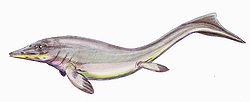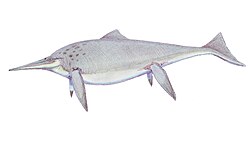Description
Fischer et al. give the diagnosis of Simbirskiasaurus as follows: "Platypterygiine ophthalmosaurid characterized by the following autapomorphies: external naris divided by a nasomaxillary pillar; posterior opening of the narial complex with anteroposteriorly constricted dorsal extension; deeply interdigitating prefrontal–lacrimal suture [reminiscent of the basal neoichthyosaurian Temnodontosaurus platyodon (Conybeare, 1822); see Godefroit, 1993]. Simbirskiasaurus birjukovi is also characterized by the following unique combination of features: subnarial process of the premaxilla reaches the posterior margin of the external naris (shared with Cryopterygius kristiansenae Druckenmiller et al., 2012); elongated anterior process of the maxilla, reaching anteriorly the level of the nasal [unlike in Aegirosaurus leptospondylus Bardet & Fernández, 2000 and Sveltonectes insolitus (Fischer et al., 2011b)]; pres- ence of a supranarial process of the premaxilla [shared with Platypterygius australis (McCoy, 1867), see Kear, 2005, and possibly Pervushovisaurus bannovkensis (Arkhangelsky, 1998b)]." [2]
This page is based on this
Wikipedia article Text is available under the
CC BY-SA 4.0 license; additional terms may apply.
Images, videos and audio are available under their respective licenses.







